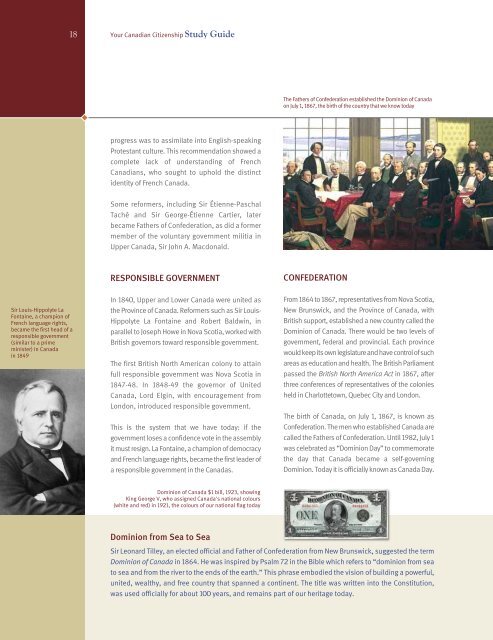Discover Canada
Discover Canada
Discover Canada
Create successful ePaper yourself
Turn your PDF publications into a flip-book with our unique Google optimized e-Paper software.
18<br />
Sir Louis-Hippolyte La<br />
Fontaine, a champion of<br />
French language rights,<br />
became the first head of a<br />
responsible government<br />
(similar to a prime<br />
minister) in <strong>Canada</strong><br />
in 1849<br />
Your Canadian Citizenship Study Guide<br />
progress was to assimilate into English-speaking<br />
Protestant culture. This recommendation showed a<br />
complete lack of understanding of French<br />
Canadians, who sought to uphold the distinct<br />
identity of French <strong>Canada</strong>.<br />
Some reformers, including Sir Étienne-Paschal<br />
Taché and Sir George-Étienne Cartier, later<br />
became Fathers of Confederation, as did a former<br />
member of the voluntary government militia in<br />
Upper <strong>Canada</strong>, Sir John A. Macdonald.<br />
RESPONSIBLE GOVERNMENT<br />
In 1840, Upper and Lower <strong>Canada</strong> were united as<br />
the Province of <strong>Canada</strong>. Reformers such as Sir Louis-<br />
Hippolyte La Fontaine and Robert Baldwin, in<br />
parallel to Joseph Howe in Nova Scotia, worked with<br />
British governors toward responsible government.<br />
The first British North American colony to attain<br />
full responsible government was Nova Scotia in<br />
1847-48. In 1848-49 the governor of United<br />
<strong>Canada</strong>, Lord Elgin, with encouragement from<br />
London, introduced responsible government.<br />
This is the system that we have today: if the<br />
government loses a confidence vote in the assembly<br />
it must resign. La Fontaine, a champion of democracy<br />
and French language rights, became the first leader of<br />
a responsible government in the <strong>Canada</strong>s.<br />
Dominion of <strong>Canada</strong> $1 bill, 1923, showing<br />
King George V, who assigned <strong>Canada</strong>'s national colours<br />
(white and red) in 1921, the colours of our national flag today<br />
Dominion from Sea to Sea<br />
The Fathers of Confederation established the Dominion of <strong>Canada</strong><br />
on July 1, 1867, the birth of the country that we know today<br />
CONFEDERATION<br />
From 1864 to 1867, representatives from Nova Scotia,<br />
New Brunswick, and the Province of <strong>Canada</strong>, with<br />
British support, established a new country called the<br />
Dominion of <strong>Canada</strong>. There would be two levels of<br />
government, federal and provincial. Each province<br />
would keep its own legislature and have control of such<br />
areas as education and health. The British Parliament<br />
passed the British North America Act in 1867, after<br />
three conferences of representatives of the colonies<br />
held in Charlottetown, Quebec City and London.<br />
The birth of <strong>Canada</strong>, on July 1, 1867, is known as<br />
Confederation. The men who established <strong>Canada</strong> are<br />
called the Fathers of Confederation. Until 1982, July 1<br />
was celebrated as “Dominion Day” to commemorate<br />
the day that <strong>Canada</strong> became a self-governing<br />
Dominion. Today it is officially known as <strong>Canada</strong> Day.<br />
Sir Leonard Tilley, an elected official and Father of Confederation from New Brunswick, suggested the term<br />
Dominion of <strong>Canada</strong> in 1864. He was inspired by Psalm 72 in the Bible which refers to “dominion from sea<br />
to sea and from the river to the ends of the earth.” This phrase embodied the vision of building a powerful,<br />
united, wealthy, and free country that spanned a continent. The title was written into the Constitution,<br />
was used officially for about 100 years, and remains part of our heritage today.



